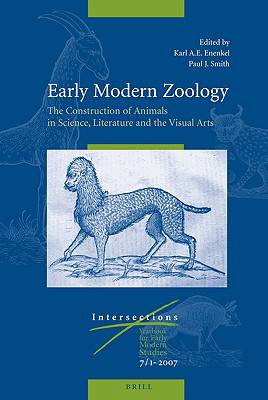
- Afhalen na 1 uur in een winkel met voorraad
- Gratis thuislevering in België vanaf € 30
- Ruim aanbod met 7 miljoen producten
- Afhalen na 1 uur in een winkel met voorraad
- Gratis thuislevering in België vanaf € 30
- Ruim aanbod met 7 miljoen producten
Zoeken
Early Modern Zoology: The Construction of Animals in Science, Literature and the Visual Arts (Set 2 Volumes)
Enenkel Karl
€ 199,46
Omschrijving
The new definition of the animal is one of the fascinating features of the intellectual life of the early modern period. The sixteenth century saw the invention of the new science of zoology. This went hand in hand with the (re)discovery of anatomy, physiology and - in the seventeenth century - the invention of the microscope. The discovery of the new world confronted intellectuals with hitherto unknown species, which found their way into courtly menageries, curiosity cabinets and academic collections. Artistic progress in painting and drawing brought about a new precision of animal illustrations. In this volume, specialists from various disciplines (Neo-Latin, French, German, Dutch, History, history of science, art history) explore the fascinating early modern discourses on animals in science, literature and the visual arts. The volume is of interest for all students of the history of science and intellectual life, of literature and art history of the early modern period.
Contributors include Rebecca Parker Brienen, Paulette Choné, Sarah Cohen, Pia Cuneo, Louise Hill Curth, Florike Egmond, Karl A.E. Enenkel, Susanne Hehenberger, Annemarie Jordan-Gschwendt, Erik Jorink, Johan Koppenol, Almudena Perez de Tudela, Vibeke Roggen, Franziska Schnoor, Paul J. Smith, Thea Vignau-Wilberg, and Suzanne J. Walker.
Contributors include Rebecca Parker Brienen, Paulette Choné, Sarah Cohen, Pia Cuneo, Louise Hill Curth, Florike Egmond, Karl A.E. Enenkel, Susanne Hehenberger, Annemarie Jordan-Gschwendt, Erik Jorink, Johan Koppenol, Almudena Perez de Tudela, Vibeke Roggen, Franziska Schnoor, Paul J. Smith, Thea Vignau-Wilberg, and Suzanne J. Walker.
Specificaties
Betrokkenen
- Auteur(s):
- Uitgeverij:
Inhoud
- Aantal bladzijden:
- 336
- Taal:
- Engels
- Reeks:
- Reeksnummer:
- nr. 7
Eigenschappen
- Productcode (EAN):
- 9789004131880
- Verschijningsdatum:
- 1/11/2007
- Uitvoering:
- Hardcover
- Formaat:
- Genaaid
- Afmetingen:
- 168 mm x 246 mm
- Gewicht:
- 1224 g

Alleen bij Standaard Boekhandel
Beoordelingen
We publiceren alleen reviews die voldoen aan de voorwaarden voor reviews. Bekijk onze voorwaarden voor reviews.











